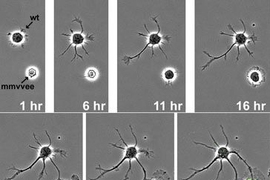MIT researchers have identified a family of proteins key to the formation of the communication networks critical for normal brain function. Their research could lead to new treatments for brain injury and disease.
The team, led by MIT biology professor Frank Gertler, found that a certain family of proteins is necessary to direct the formation of axons and dendrites, the cellular extensions that facilitate communication between neurons.
The work focuses on cellular outgrowths called neurites, which are the precursors to axons and dendrites. Understanding how neurites form could eventually lead to therapies involving stimulation of neurite growth, said Gertler.
"You could use these insights to help repair injuries to the top of the spinal column, or treat brain injuries or neurodegenerative disorders," he said.
The researchers developed the first model that allows for study of the effects of this protein family, known as the Ena/VASP proteins. The team reported aspects of their work in the Nov. 11 issue of Neuron and the Nov. 18 online edition of Nature Cell Biology.
The majority of neurons in the cerebral cortex have a single axon--a long, thin extension that relays information to other cells--and many shorter dendrites, which receive messages from other cells. The interconnection of these axons and dendrites is essential to create a functional neural circuit.
In their study, the researchers found that mice without the three Ena/VASP proteins did produce brain cells, but those neurons were unable to extend any axons or dendrites.
It was already known that Ena/VASP proteins are involved in axon navigation, but the researchers were surprised to find that they are also critical for neurite formation, Gertler said.
Ena/VASP proteins are located in the tips of a neurite's filopodia, which are short extensions that receive environmental signals and translate them into instructions for the cell. Those instructions tell the cell whether to continue extending the filopodia by lengthening actin protein filaments, or to stop growth.
Without the Ena/VASP proteins, neurites cannot form, and no connections are made between neurons.
The researchers believe that Ena/VASP proteins control the growth of filopodia by regulating actin filaments' interactions with microtubules in the cell (which form part of the cell skeleton). One theory is that the microtubules might be delivering materials or sending signals to the filopodia through the actin filaments, Gertler said.
Lead authors of the Neuron paper are Adam Kwiatkowski, an MIT Ph.D. recipient, and graduate student Douglas Rubinson. Lead author of the Nature Cell Biology paper is former MIT postdoctoral fellow Erik Dent.
The research was funded by the National Institutes of Health and the Stanley Center for Psychiatric Research at the Broad Institute of MIT and Harvard.
A version of this article appeared in MIT Tech Talk on December 5, 2007 (download PDF).













